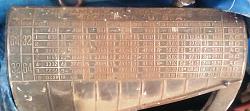

cmarlow (Sep 1, 2021), NortonDommi (Aug 28, 2021), nova_robotics (Sep 1, 2021)


The risers were there when I got it. When Toolmaker 51 stopped by one day and got a real good look at it he said he thought they may have been a factory installed option judging by the way the gear train for the lead screw and feed gears was set up.
I has at least as 56" swing and can swing a full 36 inches over the carriage 11 feet between the centers. It came with an 12" steady rest and had a tiny little 8" 3 jaw chuck clamped in the 36?" diameter 4 jaw its fastest RPM is something like 260 and a low of 6 RPM Another strange thing is it can thread from 1/2 thread per inch through 28 TPI with just about every common thread in between

Never try to tell me it can't be done
When I have to paint I use KBS products
earz (Aug 28, 2021), NortonDommi (Aug 29, 2021), Toolmaker51 (Aug 29, 2021)

I don't seem to find the API chart that used to show nominal ODs versus TPI so we might have to try this
Acme threads might be a reasonable way to come up with an OD for a 1/2 TPI, 2 TPI are typical for ODs ranging from 3 to 5 inches this is where my 14th edition of the machinery's hand book stops. it does give the dimensions for a 1 TPI thread but no mention of typical diameters the Same with my 8th edition Marks standard handbook for Mechanical engineers. Other types of threads seem to bottom out around 3 TPI with some references to 2.5 TPI
But looking at this another way think of a round grove that is used on larger winch drums called a Lebous grove. The 1/2 TPI would equate to a 2" wire rope and if we were to take half the minimum recommended pulley diameter to be 20 times the diameter of the wire rope as a starting point for a minimum bend radius however 30 to 40 times the diameter of the wire rope is more commonly used in practice for fatigue life, a 20" diameter cylinder would be the smallest the 1/2 TPI would ever be used for
Never try to tell me it can't be done
When I have to paint I use KBS products
earz (Aug 29, 2021), NortonDommi (Aug 29, 2021), Toolmaker51 (Aug 29, 2021)

Actually I should say that the 20" diameter would be the smallest I believe a 1/2 TPI would be used for at least for wire rope
I could see the 1/2 TPI being used on a 2 to 4 inch shaft as as level wind shaft but even then if this were to be for wire rope the amount of mechanical force needed to push the rope from side to side a level wind shaft for 2 inch wire rope would probably have to be in the 6" and up diameter range particularly if the winch drum was very wide.
Braided or twisted fiber 2 " cordage might use much smaller diameters though.
Never try to tell me it can't be done
When I have to paint I use KBS products
Boring a centrifugal pump on a lathe; inventive rig at least.
Appears centerline of casting too high for line-boring, which could have lessened many complications. Again, they aren't symmetrical, that would be not insurmountable challenge. No one has these sitting around. Driver they made 2-3 days build time, could sit years before next use, probably require a different pump housing fixture....
Well equipped shops use either horizontal or vertical boring mills, they're built for work like this; so, no special set-up required.
Frank S is correct, examined it first hand, it is very factory or done in job shop with all necessary facilities - even casting iron. Also correct about oddly geared lead screws; common thread specifications are not the full range of use.
Many proprietary combinations have been devised; some to confound repair or substitute parts, others to prevent unintended coupling; like fire equipment.
(i.e.) Cap for urn I made needed 7-1/2 TPI A proper Urn
At same shop here in CA, completed an emergency job for Honda Center, cooling plant shut down for broken water main. I parted off an 18" Sch-80 PVC flange fitting on a riser-equipped L&S 16/20 that swings 33" or so. It took every bit of cross slide, compound rotated 90° to left, two piece jaws assembled at outer notch, bit extended minimal amount for wall thickness, and minor details. PVC is thermoplastic, so helper poured straight water to keep chips flowing out; didn't want coolant film that might contaminate the glue joint.
Regarding raised machines; probably largest part I've faced with that situation. A raised machine still works, but aggravates leverage on width between the ways vs the carriage and cross slide, a taller, more acute angle than before, therefore losing some stability.

Sincerely,
Toolmaker51
...we'll learn more by wandering than searching...
Frank S (Aug 29, 2021)
There are currently 1 users browsing this thread. (0 members and 1 guests)
Bookmarks